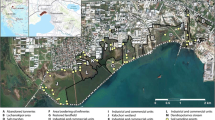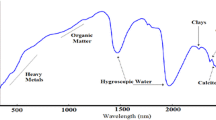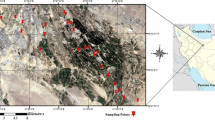Abstract
Soil pollution by arsenic is a serious environmental problem in many mining areas. Quick identification of the amount and extent of the pollution is an important basis for developing appropriate remediation strategies. In a case study, 55 soil samples were collected from a highly heterogeneous waste dump around the Sarcheshmeh copper mine, south east Iran. Samples’ visible and near-infrared (VNIR) reflectance spectra were measured, transformed to absorbance and then pre-processed using Savitzky–Golay first-derivative (FD) and Savitzky–Golay second-derivative (SD) transformation methods. The obtained spectra were then subjected to three regression models including principal component regression (PCR), partial least squares regression (PLSR) and support vector regression (SVR) for predicting arsenic concentration. The best prediction accuracies were obtained by SVR and PLSR methods applied on first-derivative pre-processed spectra with R 2 values of 0.81 and 0.69, respectively. It was found that VNIR spectroscopy is a successful method for predicting As concentration in contaminated soils of the dumpsites. Study of the prediction mechanism showed that the intercorrelation between arsenic and spectral features of soil including iron oxy/hydroxides and clay minerals was the major mechanism enabling the prediction of arsenic concentration. However, higher values of correlation coefficients at ~460, ~560 and ~590 nm suggested the internal association between arsenic and iron minerals as the more important mechanism for prediction. This conclusion supported previous speciation studies conducted in the same waste dump using improved correlation analysis and chemical sequential extraction method.










Similar content being viewed by others
References
Adeline KRM, Gomez C, Gorretta N, Roger JM (2017) Predictive ability of soil properties to spectral degradation from laboratory Vis-NIR spectroscopy data. Geoderma 288:143–153. doi:10.1016/j.geoderma.2016.11.010
Alloway B (2013) Heavy metals in soil: trace metals and metalloids in soil and their bioavailability. Springer, Reading
Bao N, Wu L, Ye B, Yang K, Zhou W (2017) Assessing soil organic matter of reclaimed soil from a large surface coal mine using a field spectroradiometer in laboratory. Geoderma 288:47–55. doi:10.1016/j.geoderma.2016.10.033
Bech J, Poschenrieder C, Llugany M, Barceló J, Tume P, Tobias F, Barranzuela J, Vásquez E (1997) Arsenic and heavy metal contamination of soil and vegetation around a copper mine in Northern Peru. Sci Total Environ 203:83–91
Ben-Dor E, Banin A (1990) Near-infrared reflectance analysis of carbonate concentration in soils. Appl Spectrosc 44:1064–1069
Ben-Dor E, Chabrillat S, Demattê J, Taylor G, Hill J, Whiting M, Sommer S (2009) Using imaging spectroscopy to study soil properties. Remote Sens Environ 113:S38–S55
Cambou A, Cardinael R, Kouakoua E, Villeneuve M, Durand C, Barthès BG (2016) Prediction of soil organic carbon stock using visible and near infrared reflectance spectroscopy (VNIRS) in the field. Geoderma 261:151–159. doi:10.1016/j.geoderma.2015.07.007
Cattle JA, McBratney A, Minasny B (2002) Kriging method evaluation for assessing the spatial distribution of urban soil lead contamination. J Environ Qual 31:1576–1588
Centeno JA, Tseng C-H, Van der Voet GB, Finkelman RB (2007) Global impacts of geogenic arsenic: a medical geology research case. AMBIO J Hum Environ 36:78–81
Chakraborty S, Weindorf DC, Paul S, Ghosh B, Li B, Ali MN, Ghosh RK, Ray D, Majumdar K (2015) Diffuse reflectance spectroscopy for monitoring lead in landfill agricultural soils of India. Geoderma Reg 5:77–85
Chakraborty S, Weindorf DC, Deb S, Li B, Paul S, Choudhury A, Ray DP (2017) Rapid assessment of regional soil arsenic pollution risk via diffuse reflectance spectroscopy. Geoderma 289:72–81
Chang C-W, Laird DA, Hurburgh CR Jr (2005) Influence of soil moisture on near-infrared reflectance spectroscopic measurement of soil properties. Soil Sci 170:244–255
Chen T, Chang Q, Clevers J, Kooistra L (2015) Rapid identification of soil cadmium pollution risk at regional scale based on visible and near-infrared spectroscopy. Environ Pollut 206:217–226
Cheng Y-Y, Huang N-C, Chang Y-T, Sung J-M, Shen K-H, Tsai C-C, Guo H-R (2017) Associations between arsenic in drinking water and the progression of chronic kidney disease: a nationwide study in Taiwan. J Hazard Mater 321:432–439. doi:10.1016/j.jhazmat.2016.09.032
Choe E, van der Meer F, van Ruitenbeek F, van der Werff H, de Smeth B, Kim K-W (2008) Mapping of heavy metal pollution in stream sediments using combined geochemistry, field spectroscopy, and hyperspectral remote sensing: a case study of the Rodalquilar mining area, SE Spain. Remote Sens Environ 112:3222–3233. doi:10.1016/j.rse.2008.03.017
Choe E, Kim K-W, Bang S, Yoon I-H, Lee K-Y (2009) Qualitative analysis and mapping of heavy metals in an abandoned Au–Ag mine area using NIR spectroscopy. Environ Geol 58:477–482
Clark RN, King TV, Klejwa M, Swayze GA, Vergo N (1990) High spectral resolution reflectance spectroscopy of minerals. J Geophys Res Solid Earth 95:12653–12680
Collell C, Gou P, Arnau J, Comaposada J (2011) Non-destructive estimation of moisture, water activity and NaCl at ham surface during resting and drying using NIR spectroscopy. Food Chem 129:601–607
da Silva Chagas C, de Carvalho Junior W, Bhering SB, Calderano Filho B (2016) Spatial prediction of soil surface texture in a semiarid region using random forest and multiple linear regressions. Catena 139:232–240
Farifteh J, Van der Meer F, Atzberger C, Carranza E (2007) Quantitative analysis of salt-affected soil reflectance spectra: a comparison of two adaptive methods (PLSR and ANN). Remote Sens Environ 110:59–78
Fordham A, Norrish K (1983) The nature of soil particles particularly those reacting with arsenate in a series of chemically treated samples. Soil Res 21:455–477
Gannouni S, Rebai N, Abdeljaoued S (2012) A spectroscopic approach to assess heavy metals contents of the mine waste of Jalta and Bougrine in the north of Tunisia. J Geogr Inf Syst 4:242
Genú AM, Demattê JAM (2011) Prediction of soil chemical attributes using optical remote sensing. Acta Sci Agron 33:723–727
Gholizadeh A, Boruvka L, Saberioon M (2015a) Spectroscopic approach to assess potentially toxic elements of reclaimed dumpsites in the Czech Republic. Int J Environ Sci Dev 6:571
Gholizadeh A, Borůvka L, Saberioon MM, Kozak J, Vašát R, Němeček K (2015b) Comparing different data preprocessing methods for monitoring soil heavy metals based on soil spectral features. Soil Water Res 10:218–227
Gholizadeh A, Borůvka L, Vašát R, Saberioon M, Klement A, Kratina J, Tejnecký V, Drábek O (2015c) Estimation of potentially toxic elements contamination in anthropogenic soils on a brown coal mining dumpsite by reflectance spectroscopy: a case study. PLoS ONE 10:e0117457
Gomez C, Lagacherie P, Coulouma G (2012) Regional predictions of eight common soil properties and their spatial structures from hyperspectral Vis–NIR data. Geoderma 189:176–185
Hearst MA, Dumais ST, Osman E, Platt J, Scholkopf B (1998) Support vector machines. IEEE Intell Syst Appl 13:18–28
Hong-Yan R, Zhuang D-F, Singh A, Jian-Jun P, Dong-Sheng Q, Run-He S (2009) Estimation of As and Cu contamination in agricultural soils around a mining area by reflectance spectroscopy: a case study. Pedosphere 19:719–726
Jannesar Malakooti S, Shafaei Tonkaboni SZ, Noaparast M, Doulati Ardejani F, Naseh R (2014) Characterisation of the Sarcheshmeh copper mine tailings, Kerman province, southeast of Iran. Environ Earth Sci 71:2267–2291
Jung MC, Thornton I, Chon H-T (2002) Arsenic, Sb and Bi contamination of soils, plants, waters and sediments in the vicinity of the Dalsung Cu–W mine in Korea. Sci Total Environ 295:81–89
Kemper T, Sommer S (2002) Estimate of heavy metal contamination in soils after a mining accident using reflectance spectroscopy. Environ Sci Technol 36:2742–2747
Khorasanipour M, Aftabi A (2011) Environmental geochemistry of toxic heavy metals in soils around Sarcheshmeh porphyry copper mine smelter plant, Rafsanjan, Kerman, Iran. Environ Earth Sci 62:449–465
Knox N, Grunwald S, McDowell M, Bruland G, Myers D, Harris W (2015) Modelling soil carbon fractions with visible near-infrared (VNIR) and mid-infrared (MIR) spectroscopy. Geoderma 239:229–239
Kooistra L, Wehrens R, Leuven R, Buydens L (2001) Possibilities of visible–near-infrared spectroscopy for the assessment of soil contamination in river floodplains. Anal Chim Acta 446:97–105
Kooistra L, Wanders J, Epema G, Leuven R, Wehrens R, Buydens L (2003) The potential of field spectroscopy for the assessment of sediment properties in river floodplains. Anal Chim Acta 484:189–200
Li M (2006) Ecological restoration of mineland with particular reference to the metalliferous mine wasteland in China: a review of research and practice. Sci Total Environ 357:38–53
Madejova J, Komadel P (2001) Baseline studies of the clay minerals society source clays: infrared methods. Clays Clay Miner 49:410–432
Martens H, Naes T (1989) Multivariate calibration. Wiley, Chichester
McCarty G, Reeves J, Reeves V, Follett R, Kimble J (2002) Mid-infrared and near-infrared diffuse reflectance spectroscopy for soil carbon measurement. Soil Sci Soc Am J 66:640–646
Mori M, K-i Tsunoda, Aizawa S, Saito Y, Koike Y, Gonda T, Abe S, Suzuki K, Yuasa Y, Kuge T (2017) Fractionation of radiocesium in soil, sediments, and aquatic organisms in Lake Onuma of Mt. Akagi, Gunma Prefecture using sequential extraction. Sci Total Environ 575:1247–1254
Mouazen AM, Kuang B, De Baerdemaeker J, Ramon H (2010) Comparison among principal component, partial least squares and back propagation neural network analyses for accuracy of measurement of selected soil properties with visible and near infrared spectroscopy. Geoderma 158:23–31. doi:10.1016/j.geoderma.2010.03.001
Nachman KE, Ginsberg GL, Miller MD, Murray CJ, Nigra AE, Pendergrast CB (2017) Mitigating dietary arsenic exposure: current status in the United States and recommendations for an improved path forward. Sci Total Environ 581:221–236
Nawar S, Buddenbaum H, Hill J, Kozak J, Mouazen AM (2016) Estimating the soil clay content and organic matter by means of different calibration methods of vis-NIR diffuse reflectance spectroscopy. Soil Tillage Res 155:510–522. doi:10.1016/j.still.2015.07.021
Nayak PS, Singh B (2007) Instrumental characterization of clay by XRF, XRD and FTIR. Bull Mater Sci 30:235–238
Niazi NK, Singh B, Van Zwieten L, Kachenko AG (2011) Phytoremediation potential of Pityrogramma calomelanos var. austroamericana and Pteris vittata L. grown at a highly variable arsenic contaminated site. Int J Phytoremediation 13:912–932
Niazi NK, Singh B, Minasny B (2015) Mid-infrared spectroscopy and partial least-squares regression to estimate soil arsenic at a highly variable arsenic-contaminated site. Int J Environ Sci Technol 12:1965–1974
Nocita M, Stevens A, Noon C, van Wesemael B (2013) Prediction of soil organic carbon for different levels of soil moisture using Vis-NIR spectroscopy. Geoderma 199:37–42
Nocita M, Stevens A, Toth G, Panagos P, van Wesemael B, Montanarella L (2014) Prediction of soil organic carbon content by diffuse reflectance spectroscopy using a local partial least square regression approach. Soil Biol Biochem 68:337–347
Rodionov A, Pätzold S, Welp G, Pude R, Amelung W (2016) Proximal field Vis-NIR spectroscopy of soil organic carbon: a solution to clear obstacles related to vegetation and straw cover. Soil Tillage Res 163:89–98
Rossel RAV, Behrens T (2010) Using data mining to model and interpret soil diffuse reflectance spectra. Geoderma 158:46–54
Saeys W, Mouazen AM, Ramon H (2005) Potential for onsite and online analysis of pig manure using visible and near infrared reflectance spectroscopy. Biosyst Eng 91:393–402
Santra P, Singh R, Sarathjith M, Panwar N, Varghese P, Das B (2015) Reflectance spectroscopic approach for estimation of soil properties in hot arid western Rajasthan, India. Environ Earth Sci 74:4233–4245
Schneider IL, Teixeira EC, Rolim SB, Hallouche B (2015) Study of reflectance spectroscopy in river sediments. Int J Adv Remote Sens GIS 4:1271–1285
Shamsoddini A, Raval S, Taplin R (2014) Spectroscopic analysis of soil metal contamination around a derelict mine site in the Blue Mountains, Australia. ISPRS Ann Photogramm Remote Sens Spat Inf Sci 2:75
Shi T, Cui L, Wang J, Fei T, Chen Y, Wu G (2013) Comparison of multivariate methods for estimating soil total nitrogen with visible/near-infrared spectroscopy. Plant Soil 366:363–375. doi:10.1007/s11104-012-1436-8
Shi T, Chen Y, Liu Y, Wu G (2014) Visible and near-infrared reflectance spectroscopy-an alternative for monitoring soil contamination by heavy metals. J Hazard Mater 265:166–176
Siebielec G, McCarty GW, Stuczynski TI, Reeves JB (2004) Near-and mid-infrared diffuse reflectance spectroscopy for measuring soil metal content. J Environ Qual 33:2056–2069
Song Y, Li F, Yang Z, Ayoko GA, Frost RL, Ji J (2012) Diffuse reflectance spectroscopy for monitoring potentially toxic elements in the agricultural soils of Changjiang River Delta, China. Appl Clay Sci 64:75–83
Sun W, Zhang X (2017) Estimating soil zinc concentrations using reflectance spectroscopy. Int J Appl Earth Obs Geoinf 58:126–133
Thomas R (2013) Practical guide to ICP-MS: a tutorial for beginners. CRC Press, Boca Raton
Vasques G, Grunwald S, Sickman J (2008) Comparison of multivariate methods for inferential modeling of soil carbon using visible/near-infrared spectra. Geoderma 146:14–25. doi:10.1016/j.geoderma.2008.04.007
Vicente LE, de Souza Filho CR (2011) Identification of mineral components in tropical soils using reflectance spectroscopy and advanced spaceborne thermal emission and reflection radiometer (ASTER) data. Remote Sens Environ 115:1824–1836
Wang Q, Li P, Chen X (2012) Modeling salinity effects on soil reflectance under various moisture conditions and its inverse application: a laboratory experiment. Geoderma 170:103–111
Waterman GC, Hamilton R (1975) The Sar Cheshmeh porphyry copper deposit. Econ Geol 70:568–576
White WB (1971) Infrared characterization of water and hydroxyl ion in the basic magnesium carbonate minerals. Am Mineral 56:46–53
Wijewardane NK, Ge Y, Morgan CL (2016) Moisture insensitive prediction of soil properties from VNIR reflectance spectra based on external parameter orthogonalization. Geoderma 267:92–101
Wold S, Martens H, Wold H (1983) The multivariate calibration problem in chemistry solved by the PLS method. In: Kagstrom B, Ruhe A (eds) Matrix pencils. Lecture notes in mathmatics. Springer, Berlin, pp 286–293
Wu Y, Chen J, Wu X, Tian Q, Ji J, Qin Z (2005) Possibilities of reflectance spectroscopy for the assessment of contaminant elements in suburban soils. Appl Geochem 20:1051–1059
Wu Y, Chen J, Ji J, Gong P, Liao Q, Tian Q, Ma H (2007) A mechanism study of reflectance spectroscopy for investigating heavy metals in soils. Soil Sci Soc Am J 71:918–926
Xie XL, Pan XZ, Sun B (2012) Visible and near-infrared diffuse reflectance spectroscopy for prediction of soil properties near a copper smelter. Pedosphere 22:351–366
Xuemei L, Jianshe L (2014) Using short wave visible-near infrared reflectance spectroscopy to predict soil properties and content. Spectrosc Lett 47:729–739. doi:10.1080/00387010.2013.840315
Yousefi S, Doulati Ardejani F, Ziaii M, Esmaeil Zadeh E, Abedi A, Karamoozian M (2013) Identification of the origin and behaviour of arsenic in mine waste dumps using correlation analysis: a case study Sarcheshmeh copper mine. Int J Min Geo-Eng 47:139–149
Yousefi S, Doulati Ardejani F, Ziaii M, Abedi A, Zadeh EE (2015a) Investigating the origin and geochemical behaviour of toxic elements within the waste dumps using statistical analyses: a case study at waste dumps of Sarcheshmeh copper mine, SE of Iran. Environ Earth Sci 73:1555–1572
Yousefi S, Doulati Ardejani F, Ziaii M, Karamoozian M (2015b) The speciation of cobalt and nickel at mine waste dump using improved correlation analysis: a case study of Sarcheshmeh copper mine. Environ Dev Sustain 17:1065–1084
Yu X, Liu Q, Wang Y, Liu X, Liu X (2016) Evaluation of MLSR and PLSR for estimating soil element contents using visible/near-infrared spectroscopy in apple orchards on the Jiaodong peninsula. Catena 137:340–349
Zheng GH (2011) Prediction of As in soil with reflectance spectroscopy. Spectrosc Spectr Anal 31:173–176
Zhuang DF (2009) Analysis of visible and near-infrared spectra of As-contaminated soil in croplands beside mines. Spectrosc Spectr Anal 29:114–118
Acknowledgements
The authors wish to express their gratitude to the Research and Development Division of the Sarcheshmeh Copper Complex for their cooperation to access the sampling and analysis facilities.
Author information
Authors and Affiliations
Corresponding author
Rights and permissions
About this article
Cite this article
Khosravi, V., Doulati Ardejani, F. & Yousefi, S. Spectroscopic-based assessment of the content and geochemical behaviour of arsenic in a highly heterogeneous sulphide-rich mine waste dump. Environ Earth Sci 76, 459 (2017). https://doi.org/10.1007/s12665-017-6793-4
Received:
Accepted:
Published:
DOI: https://doi.org/10.1007/s12665-017-6793-4




